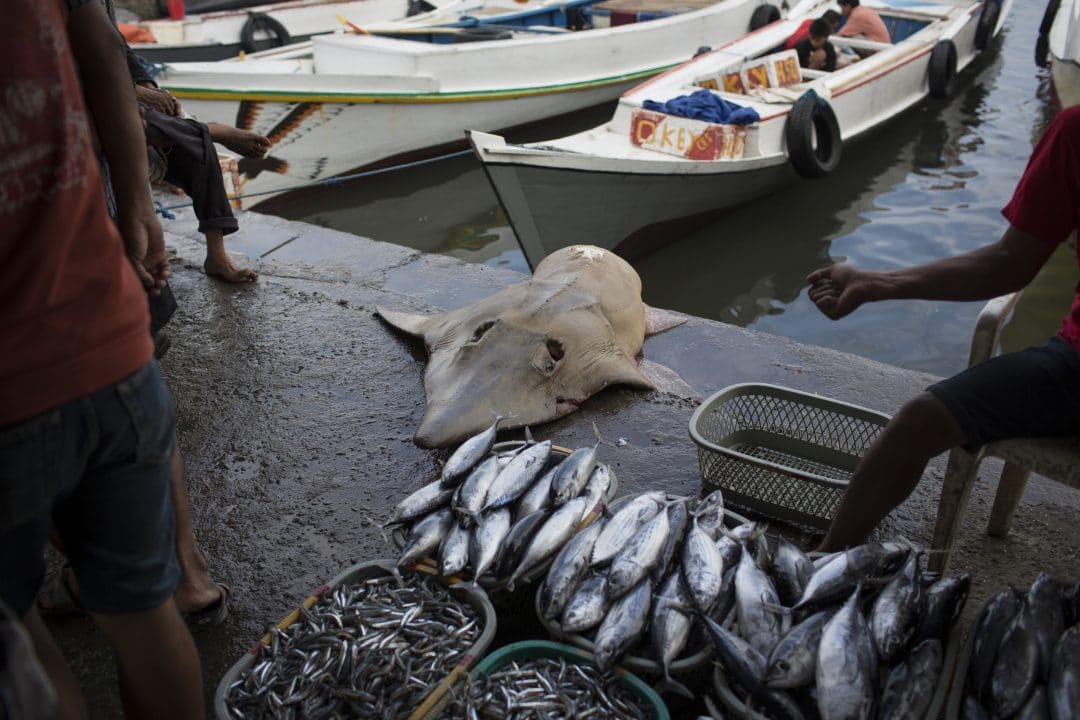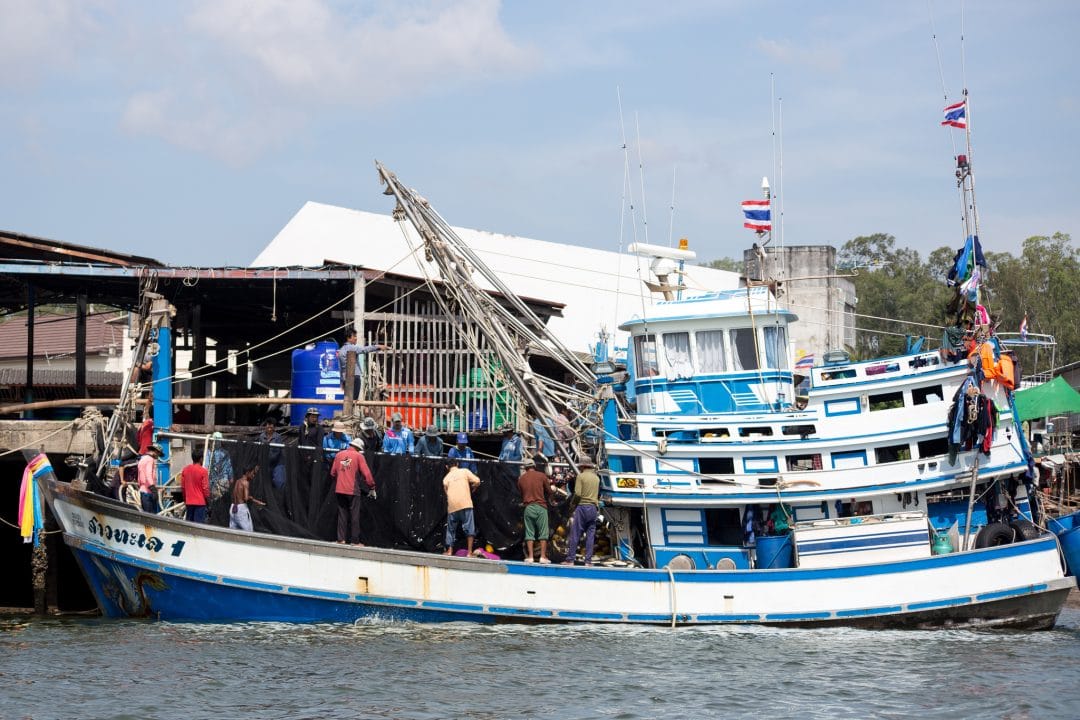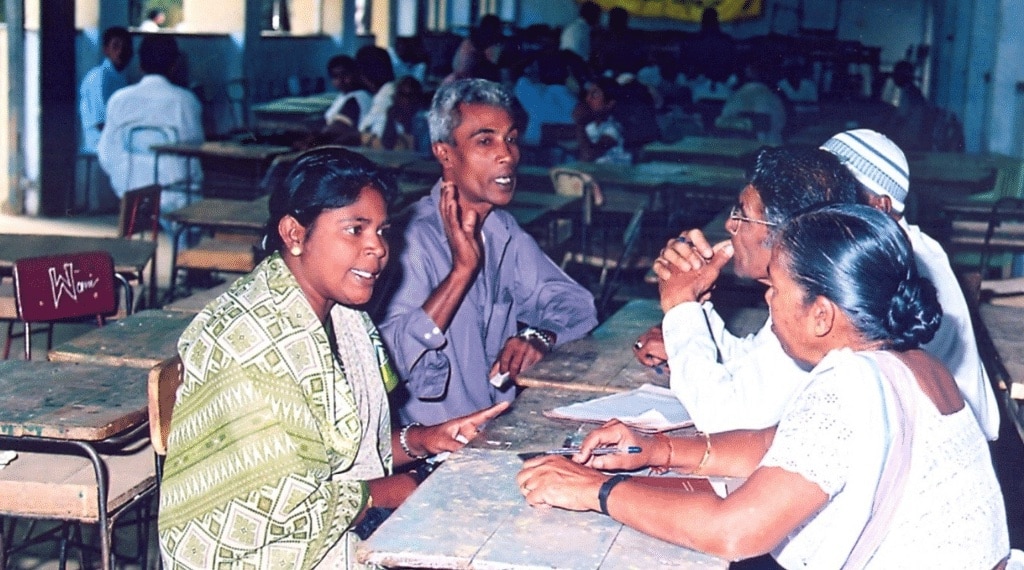InAsia
Insights and Analysis
Southeast Asia’s Fisheries Near Collapse from Overfishing
March 28, 2018
Approximately 12 percent of the world’s population relies upon fisheries and aquaculture for their livelihood, and over half of the world’s people get a significant source of their animal protein from fish and seafood. In Southeast Asia, this proportion is significantly higher. The region’s seas not only serve as a major source of food and livelihood for hundreds of millions of people, they generate several billion dollars in GDP for the region.

People collect dried shrimp which have been drying in the sun along the coast of Makassar, Indonesia. Millions of people in Southeast Asia rely on fish and seafood for protein. Photo/Conor Ashleigh
Southeast Asia has one of the most diverse marine ecosystems in the world, but overfishing and destructive fishing threaten its sustained existence. Across the region, 64 percent of the fisheries’ resource base is at a medium to high risk from overfishing, with Cambodia and the Philippines among the most heavily affected. Common methods of destructive fishing include poison fishing, which has become a pervasive commercial fishing method for live reef fish, using sodium cyanide to stun fish and make them easier to capture. Another method is blast fishing, which uses dynamite or grenades to indiscriminately kill fish in the immediate vicinity by rupturing their internal organs. While both practices are illegal in most Southeast Asian countries, they are still widely used where enforcement is limited. Bottom trawling is another destructive practice that uses “rockhopper” trawl nets that are dragged over any surface, causing extensive reef destruction. Ghost fishing is the term given to abandoned fishing gear which continues to float in the ocean, killing fish, dolphins, whales, turtles, and other creatures that become hooked or ensnared. These destructive practices severely threaten more than half of Southeast Asia’s coral reefs. Threats are particularly acute in the Spratly and Paracel Islands, where disputed resource rights have led to even more unregulated fishing.

A de-finned shark for sale at the port in Makassar, South Sulawesi. Indonesia, the 4th longest coastline country in the world, is the largest fishing nation in Southeast Asia, Fishing is a crucial part of the local economy. Photo/Conor Ashleigh
Much of the overfishing and destructive fishing in Southeast Asia is attributable to illegal, unreported, and unregulated fishing (IUU). IUU fishing occurs region-wide, with violators ranging from small-scale local fishermen to large-scale enterprises conducted on commercial fishing trawlers. There are many drivers for IUU fishing in the region, not the least of which is that demand now appears to exceed supply. Operationally, the main issue is weak fishing regulations among the region’s many countries, together with a lack of cooperation on management among these countries.

Fishermen unload a fishing net off the coast of Krabi, Thailand. Overfishing and destructive fishing has threatened Southeast Asia’s fisheries. Photo/Flickr user Alex Berger
There is also a significant lack of science-based knowledge about the region’s marine ecosystems to inform policies that would lead to the establishment of sound models for fisheries management, as well as insufficient focus on cultivating alternatives to wild catch fisheries, such as sea-farming and inland freshwater aquaculture.
As competition for remaining fish stocks grows fiercer, some experts warn that the region’s entire fisheries industry will soon collapse. Estimates suggest that in order to prevent this, all countries fishing in the region would need to cease all destructive fishing practices and reduce harvest by nearly 50 percent.
Despite widespread recognition that the region’s fishery resources are severely threatened, coordination among countries over the management, and information regarding the extent and nature of threats, remains limited. On March 13-14, The Asia Foundation, in cooperation with the U.S. Department of State, the Royal Thai Government and the People’s Republic of China, convened 80 experts—diplomats, scientists, activists, entrepreneurs, and civil society organizations—from over 20 countries throughout the Asia-Pacific region, for an ASEAN Regional Forum (ARF) in Bangkok to discuss a regional assessment of fisheries management and determine concrete ways for countries to urgently cooperate and exchange best practices to better ensure food security in Southeast Asia.
In particular, the two-day workshop explored opportunities to collaborate, including legal frameworks and institutions to improve shared management as well as to combat IUU fishing; promoting information-sharing and collaborative scientific platforms as a basis for the development of sound domestic and regional policies; strengthening ASEAN interoperability in the fisheries sector; country-level initiatives on sustainable fisheries management including aquaculture management; and emerging new technologies to support sustainable fisheries management.
Among the key messages drawn from the two-day meeting, political will topped the list. In order to seriously address the threats to sustainable fisheries management in Southeast Asia, it is necessary for government leaders and non-government actors to exercise the political will necessary for countries to move away from business-as-usual practice to new, sustainable patterns of fisheries management. Within this context, participants recommended the following priorities:
- Inclusive and synchronized legal frameworks to regulate fisheries policies across the region. Southeast Asian countries need to coordinate in the legal field and share best practices such as how to manage the requirement for sustainable fishing practices in other countries. Countries that already have their own national plans of action for IUU fishing can harmonize these plans into common regional practice. Overlapping maritime jurisdictions should be treated as a priority concern as jurisdictional disputes create obstacles for regional cooperation necessary to establish the framework for building sustainable fishing in the region.
- Regional cooperation on enforcement needs to be dramatically enhanced to address IUU fishing and improve overall sustainable fisheries management. More often than not, IUU fishing and crimes committed in the fishing industry are transnational and highly organized. Joint monitoring, surveillance and control, and subsequent investigation initiatives are pivotal to uphold sustainability of resources while preserving the sovereignty of each country.
- Information-sharing between agencies involved in fisheries management within a country and between countries is critical to improving sustainable fisheries management. Further assessments pertaining to short-falls in country-level implementation and technical capacity are needed to develop effective capacity-building programs that address identified gaps and create accountable departments and reliable networks across the region.
- Expansion of sustainable aquaculture within the region can help reduce pressures on natural fish stocks and should be actively promoted. Sea-farming can be especially helpful to small-scale fishery communities looking to shift into a more stable (and sustainable) livelihood, while expansion of freshwater aquaculture in inland farming communities can concurrently increase fish supplies sustainably.
- Ongoing dialogue on sustainable fisheries management in Southeast Asia is needed to develop concrete action steps for countries to adopt and enact. Participants agreed to continue to explore opportunities for collaboration at the policy and technical levels and to contribute to the identification of concrete goals, milestones, and next steps for sustainable fisheries management.
Perhaps the most urgent takeaway was that at current trends, time is short, and the region must work collaboratively to achieve sustainable management of the region’s precious fisheries.
Kim DeRidder, who delivered welcoming remarks at the ASEAN Regional Forum event, is director of The Asia Foundation’s Environment program. Santi Nindang is a program officer for the Foundation in Thailand. The views and opinions expressed here are those of the authors and not those of The Asia Foundation or its funders.
3 Comments
About our blog, InAsia
InAsia is posted and distributed every other Wednesday evening, Pacific Time. If you have any questions, please send an email to [email protected].
Contact
For questions about InAsia, or for our cross-post and re-use policy, please send an email to [email protected].The Asia Foundation
465 California St., 9th Floor
San Francisco, CA 94104
The Latest Across Asia
Program Snapshot
June 18, 2024
Program Snapshot
June 12, 2024
Media Coverage
June 7, 2024
Media Coverage
June 6, 2024

AsiaFoundation70
This year, we celebrate 70 years of improving lives and expanding opportunities.







I wonder who the largest consumers of fish products obtained in the region are and whether or not they were participants in the forum? It would seem pretty easy (I know it isn’t) to tell fishermen that, in exchange for you reducing your catch by 50%, your vessel and crew will be hired to police the waters and do a., b., and c. to return the fisheries to their former robustly healthy state. There will be a huge bonus paid to all participants when that has been verified. Time is too short to play games here!!
Not only are supplies dwindling but what remains are also being threatened by plastic micro-particles!
The shark picture is so sad once you read the description